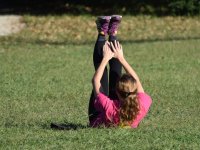Good News for Teachers: Exercise Builds Brain Power, Too
Strength training, regular exercise, better rest, and enjoying all of this activity makes you fit, alert, and positive for the physically demanding job of teaching.
Your content has been saved!
Go to My Saved Content.As many educators can attest at the end of a busy school day, teaching can be physically demanding. The good news is that all your standing, walking, stretching, and lifting, day in and day out, is as good for your brain as it is for your body.
- Regular physical activity is associated with increased production of the neurochemical BDNF, which supports the production of new neurons and synapses in your brain.
- Exercise increases mass in areas of the brain involved in executive function, memory, and spatial processing.
- The cardiovascular health effects of exercise extend to increasing the growth of blood vessels that improve oxygen flow to the brain.
- Regular workouts help to relieve stress, alleviate symptoms of depression, and enhance a positive outlook.
Getting Stronger
Adding exercise to your daily routine, such as a brisk walk, run, bike ride, or workout at the gym, can enhance these benefits and help build stamina for energetic teaching. Physical activity guidelines for adults from the Centers for Disease Control and Prevention recommend at least 150 minutes of aerobic exercise per week, and at least twice-weekly muscle-strengthening activities that work out all major muscle groups (legs, hips, back, abdomen, chest, shoulders, and arms).
Regular aerobic exercise, which gets you breathing harder and your heart beating faster, improves cardiovascular health. Even ten-minute bursts of moderate to rigorous exercise can have a positive impact on your body and brain health. Here's a good gauge of whether your workout is in the moderate or rigorous range of activity: When you're walking, doing water aerobics, or riding a bike, if you can talk but not sing, you're at a moderate level. During a rigorous workout, you won't be able to say more than a few words without pausing to catch your breath.
Aerobic exercise gets a lot of attention, but muscle-strengthening exercises are crucial for body and brain health as well. Medical research shows that strength training benefits people of all ages, adds vitality, and can counteract some effects of aging. A pound of muscle burns calories more efficiently than a pound of fat, so adding muscle can increase your metabolic rate, enhance cardiovascular health, increase levels of "good cholesterol" (HDL), and trigger muscles to use more insulin, which reduces the risk of developing diabetes.
In addition, a study by researchers at the University of British Columbia found that strength training improves the cognitive functioning and memory of older adults. Yoga, weight lifting, working with resistance bands or equipment, exercises like push ups that use your body weight for resistance, and chores that involve heavy lifting, digging, or shoveling are effective muscle-strengthening activities. As this list demonstrates, you don't need to join a gym to build muscle, but it may be helpful to consult a trainer or a good book or online resource on strength training to develop an effective regimen that will work for you.
More Exercise, Better Rest
Another dividend of regular physical activity is a better night's sleep. The stress of teaching can make it difficult to turn off your brain so that you can sleep well and wake up refreshed and ready for a new day. In a study shared by the National Sleep Foundation, participants who worked out at least 150 minutes weekly reported 65 percent better sleep quality than those who did not exercise regularly.
Getting adequate sleep (at least seven hours on average for adults) can help improve the ability to focus your attention on cognitively demanding tasks and reduce the tendency to feel sleepy or rundown during the day. Regular exercise results in more restful nights, which in turn can boost the energy that you need to take on the physical and cognitive demands of your profession.
Make It Fun
It's easier to commit to a regular activity if you enjoy it. If you develop an exercise regimen that fits your individual preferences and that you look forward to, you will be much more likely to make it a long-term routine. You might enjoy a solitary walk in the woods or prefer a Zumba class with friends. Parents and grandparents can combine family time with exercise by engaging in active play with their children and grandchildren.
A final suggestion is looking for ways to add fitness breaks throughout your busy days. Incorporate a few moments to stretch and move about the classroom with your students during transitions between lessons. Take the stairs instead of the elevator. Parking farther away from your destination adds a few extra steps when you run errands. These little habits provide refreshing reminders about the body and brain benefits of "getting physical."
For further reading:
- Conyers, M., & Wilson, D. (2015). Positively Smarter: Science and Strategies for Increasing Happiness, Achievement, and Well-Being. West Sussex, UK: Wiley Blackwell.
